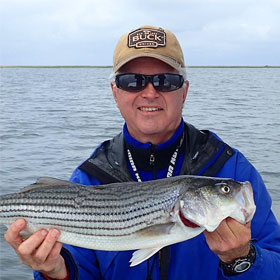Interested in Saltwater Fly Fishing? Here’s An Overview
By Ken Schultz
Aug 18, 2021
If you’re wondering whether you can fly fish in saltwater, this practical look at saltwater fly fishing opportunities explains the differences and challenges
Many people new to recreational angling wonder about fly fishing, which is one component of the whole sportfishing pie, and assume that this activity is just associated with using insect imitations and fishing for freshwater trout. But what about saltwater fly fishing? Can you fly fish in saltwater?
Sure you can. Fishing in saltwater takes many forms and can be enjoyed in many ways. You can enjoy saltwater fly fishing in the surf, from a pier, from a boat, and by wading. Perhaps the two most popular saltwater fly fishing activities are wade-fishing shallow flats - especially for redfish and bonefish - and inshore casting from a shallow-draft skiff - especially for striped bass, snook, redfish, and seatrout. Both of these activities take place along flats and in backwaters. And both often have the element of sight fishing, which is looking for, and casting to, observable fish. This requires stealth and precise presentation.
In general, fly fishing varies from other forms of fishing not only by virtue of the principle of casting nearly weightless objects, but also with respect to the selection of flies, lures, and bait. What’s notably different about saltwater fly fishing is the equipment, some additional casting challenges, and the playing and landing of fish.
If you’re completely new to angling, it would be a stretch to start with saltwater fly fishing unless you had an excellent mentor. It would be better to first get experience catching saltwater species with spinning gear, and to learn about the habits of fish and and general methodologies for catching them.
Before jumping wholeheartedly into saltwater fly fishing, you should become a proficient caster. For most people, their ability to obtain distance while flycasting is limited, and encountering windy conditions is common. It is essential, however, that you can cast a fly a reasonable distance under most circumstances. If you’re casting is good, your efforts will be more rewarding.
Many of the commonly sought saltwater species can get fairly large and will fight pretty hard. This, combined with a frequent need to cast larger and therefore bulkier flies (usually imitating baitfish), necessitates using longer and heavier rods and bigger reels (with more line capacity) than for most freshwater fly fishing.
It will usually take longer to fight and land saltwater fish than when using other tackle, so you have to get used to that. And you’ll generally play a fish off the reel, so drag quality, setting, and use becomes more of a factor than it is with freshwater species and lighter reels. Also, you’ll have to rinse down your gear after every saltwater outing, which is usually not necessary for freshwater fishing.
To get properly outfitted with saltwater fly fishing gear, visit a tackle shop that specializes in fly tackle and has knowledgeable staff. And don’t forget your fishing license.









